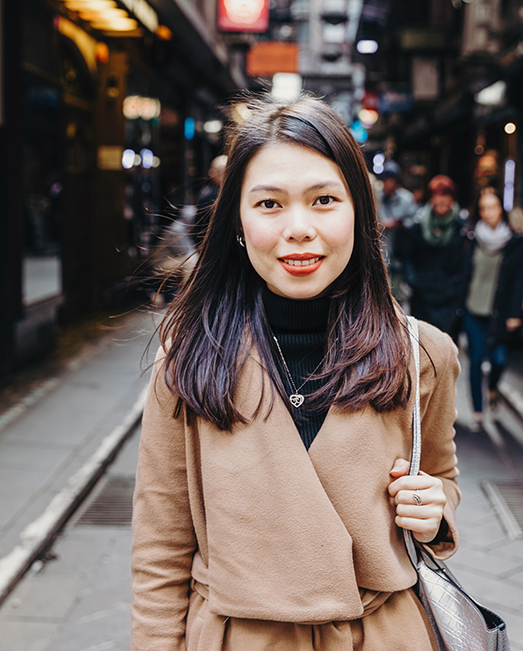Future student
Copyright@ Australian Catholic University 1998-2025 | ABN 15 050 192 660 CRICOS registered provider: 00004G | PRV12008
Copyright@ Australian Catholic University 1998-2025 | ABN 15 050 192 660 CRICOS registered provider: 00004G | PRV12008

Public health initiatives like vaccination programs, car safety laws, tobacco restrictions, and clean air and water standards have saved millions of lives across the globe. Those who study public health can have a real and lasting effect on their fellow human beings. So, what does a degree in public health look like day-to-day?
We asked Master of Public Health (Global Health and Advocacy) student Mariah Valdehueza to describe an average day.
6 – 8am
“Time to wake up and get myself ready for a long day. My day usually starts with some coffee and a podcast. I like listening to channels that keep me updated on emerging issues around the world, my favourites are The Inquiry and Global News Podcast.
Once I've had my daily dose of caffeine, I start getting ready for school by preparing my lunch, some light snacks and my water bottle. This is a must. I never leave home without it. I take a shower, get dressed, make sure I've packed the essentials and then off I go. My apartment is walking distance from ACU Melbourne Campus. It usually just takes me 15 minutes by foot to get there but, when I have some extra time I like to take it easy and appreciate my surroundings as I pass through Melbourne's famous Carlton Gardens.”
8 – 10am
“I settle in the classroom for the first lecture of the day. All subjects for my masters entail a one-hour lecture and a two-hour tutorial every week. During the lecture, professors discuss the topic of the week in a structured and more formal manner. Lecture classes are held in modern rooms with the traditional classroom setup.”
10am – 12pm
“Tutorials are longer and more spontaneous than lectures. We sit in small clusters to make it easier for us to discuss and work on group tasks. The class size is also a bit smaller than the lecture class, only around 30 – 40 students per tutorial. I like this set-up since it allows students more time to engage in a discussion with professors and classmates. It gives me the opportunity to not only learn from the professor but from my fellow classmates as well. It also gives me a chance to contribute to the class any relevant information I gained from my readings or from the experiences I have gained while working in the Philippines.”
12 – 2pm
“Break time. I first head over to where the microwaves are located so I can heat up my lunch. If the weather is good, I go straight to the rooftop of the Daniel Mannix Building where I can eat my lunch whilst enjoying the view of Melbourne. The rooftop is also a good place to relax and catch up on some reading. Sometimes, if our schedules permit, my friends and I meet up and have lunch together at the school cafeteria. To prepare for my afternoon classes, I make sure to grab some coffee and refill my water bottle before I head over to the tutorial rooms for our next class.
On days when we finish morning classes a little earlier than scheduled, I hear mass at 12pm in the campus chapel before lunch.”
2 – 5pm
“I attend my second and last tutorial. I prefer filling up my schedule with two subjects per day – that’s two lectures and two tutorials. That way, I get to spend enough time on the campus to keep me motivated and focused on school related work.”
5 – 7pm
“I squeeze in a little bit more school work just before I leave the campus. Since there's an assessment task to write every week, it is important for me to use my time efficiently without causing burnout. I try to do that by working in different areas on campus including the library, the school lobby or even the cafeteria. The Melbourne Campus has a lot of spaces where students can work, I usually choose one that's quiet and has few people.
Alternatively, I also go the State Library of Victoria which is a good 15 minute walk from the ACU campus.”
7 – 8pm
“I go home just in time for dinner. I do most of my meal preps during the weekend, so I don’t have to do much cooking during weekdays. It saves me a lot of time and it allows me to spend more time doing other important tasks. I also make sure that I always have some fruit, eggs and bread in the fridge for when things get more hectic and sitting down for a proper meal seems impossible.”
8 – 10pm
“If I’m not working on any assessment I try to prepare myself for my other subjects by going through lecture presentations or reading materials uploaded on ACU’s online learning portal. Once I’m satisfied with what I have accomplished for the day, I start getting ready for bed. I then cap off my night by catching up with my friends and loved ones back in the Philippines. There are also some nights when I have to stay up longer than usual to do more writing.
I decided to enrol at ACU because their curriculum is current and the subjects are practical. It considers emerging issues and has an international perspective that will help deepen my understanding of public health.”
Interested in a study experience like Mariah’s? Explore public health at ACU.
Copyright@ Australian Catholic University 1998-2025 | ABN 15 050 192 660 CRICOS registered provider: 00004G | PRV12008